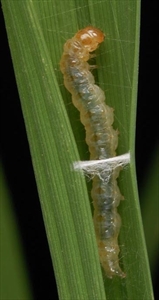Rice leaf folder
Pacific Pests, Pathogens, Weeds & Pesticides - Online edition
Pacific Pests, Pathogens, Weeds & Pesticides
Rice leaf folder (414)
Cnaphalocrocis medinalis. A moth of the Crambidae. Another species, Marasmia patnalis, looks similar, complicating identification.
Asia, Africa (Madagascar), Oceania. It is recorded from Australia, American Samoa, Cook Islands, Fiji, New Caledonia, Papua New Guinea, Samoa, and Solomon Islands.
Rice is the main host, but also on maize, millet, oats, sorghum, sugarcane, wheat, wild grasses and sedges.
The larvae spin threads that form bands across the leaf, contracting as they dry and tie the margins together, causing the leaf to roll. Inside the rolled leaves, the larvae scrape the surface tissues, creating whitish stripes. Rice fields appear scorched from the damage.
Eggs, oval, flat on lower side, about 1 mm long and 0.5 mm wide, laid singly or in small groups on the underside of the leaves. Larvae, cream at first, becoming green when mature, about 16 mm long, covered in brown hairs, and with a light-brown head (Photo 1). Pupation is within a silken cocoon inside the folded leaf. Adults are golden-yellow, straw coloured or orange-brown (Photos 2&3) with two or three dark lines across the forewings (one may be incomplete). One or two of these lines coincide with similar lines in the hindwing. The wingspan is about 16 mm. The length of the life cycle varies over the range of the moth from 21 to more than 75 days. The moth is more active in the wetter times of the year.
The adult is a strong flyer and in parts of Asia there are long distance migrations in the spring with return migrations in the autumn to over-winter as larvae or pupae.
The rice leaf folder is the most important species of leaf folder in upland, irrigated and rainfed wetland rice. The use of high-yielding varieties and the increase of insecticides and nitrogenous fertilizers has caused major outbreaks throughout Asia and Oceania, including Fiji. Recently, however, farmers are reducing insecticide use during the first 40 days as they now know that plants can compensate for the early damage.
Look for folded leaves, larvae and frass. The similarity of this and another leaf folder, Marasmia patnalis, means that expert examination of specimens is needed to ensure correct identification. In the adult, the patterns on the forewings and sexual features are needed to separate these two leaf folders. Note, the distribution of, Marasmia patnalis, according to CABI, is India, Indonesia, Malaysia, Philippines and Sri Lanka.
BIOSECURITY
Countries not yet infested by the rice leaf folder should consider all likely pathways for entry, and apply quarantine measures accordingly. It is a major pest of rice, in particular. Many countries throughout Africa, the Americas and also Oceania are at risk. Pathways of introduction are likely to be via produce contaminated by pieces of stem of the hosts infested with larvae or pupae.
NATURAL ENEMIES
Many egg, larval and pupal parasitoids (e.g., braconid, bethylid, encyrtid, ichneumonid, trichogrammatid species) and predators (e.g., coccinellids, anthocorids, mirids, pentatomids, reduviids, and spiders) attack the rice leaf folder. The most effective parasitoids and predators vary within the different regions of Asia where the leaf folder occurs.
CULTURAL CONTROL
Before planting:
- Remove weeds on the bunds as many are hosts of the larvae.
- Fallow land after rice, or if that is not possible rotate with a different crop.
During growth:
- Do not over apply fertilizer: apply recommended doses at the times suggested. Get advice from government extension officers if this is not known.
- Weed as required, removing alternative hosts of the rice leaf folder.
After harvest:
- Avoid ratooning the crop as the larvae can carry over to the new tillers as they emerge.
- Flood the field after harvest or, if not possible, plough the land, turning the stubble into the soil.
RESISTANT VARIETIES
Many varieties have been bred for resistance. Seek advice from your agricultural extension agent to see if they are available in your country.
CHEMICAL CONTROL
Insecticides are best avoided in the early stages of rice growth, especially as crops can recover from damage caused in the first 40 days. If insecticides are need, i.e., if infestations are high during the booting stage and the flag-leaf is damaged, do the following:
- Use biorational insecticides, such as neem seed oil (oil from the fruits and seeds of the neem tree, Azadirachta indica); abamectin (a fermentation product from a soil bacterium); or spinosad (isolated from a soil actinomycete).
- In Fiji, the carbamate, carbaryl, has been recommended. Other synthetic products, e.g., pyrethroids, such as cypermethrin are likely to be effective, but will destroy parasitoids and predators.
- Insecticides may destroy the parasitoids and predators of OTHER insects, e.g., the brown plant hopper, and result in a rapid increase (‘resurgence’) of populations.
____________________
When using a pesticide, always wear protective clothing and follow the instructions on the product label, such as dosage, timing of application, and pre-harvest interval. Recommendations will vary with the crop and system of cultivation. Expert advice on the most appropriate pesticide to use should always be sought from local agricultural authorities.
AUTHOR Grahame Jackson
Information from CABI (2019) Cnaphalocrocis medinalis (rice leaf folder). Crop Protection Compendium. (https://www.cabi.org/cpc/datasheet/50238); and Leaf folder management in rice. Plantwise Fact sheets for farmers. CABI Plantwise Knowledge Bank. (https://www.plantwise.org/KnowledgeBank/factsheetforfarmers/20147800010); and (including Photo 1) from Catindig J (undated) Rice leaffolder, Cnaphalocrocis medinalis. Rice Knowledge Bank. IRRI.(http://www.knowledgebank.irri.org/training/fact-sheets/pest-management/insects/item/rice-leaffolder). Photo 2 Rice leaf roller moth (Cnaphalocrocis medinalis) on a building wall in Canungra, Queensland, Australia. (https://commons.wikimedia.org/wiki/File:Rice_Leaf_Roller.JPG). Photo 3 McCormack, Gerald (2007) Cook Islands Biodiversity Database, Version 2007.2. Cook Islands Natural Heritage Trust, Rarotonga. Online at http://cookislands.bishopmuseum.org/results.asp?ebg=Cnaphalocrocis+&Submit=Search&search=true.
Produced with support from the Australian Centre for International Agricultural Research under project HORT/2016/185: Responding to emerging pest and disease threats to horticulture in the Pacific islands, implemented by the University of Queensland and the Secretariat of the Pacific Community.






